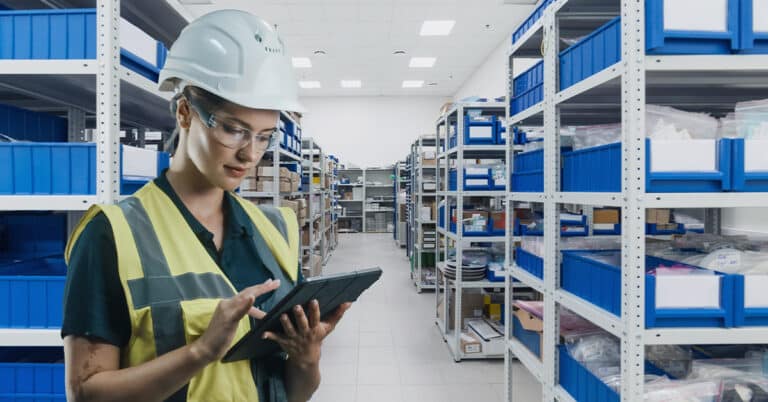If you’re looking for opportunities to improve operations and increase your competitive advantage, analyzing the manufacturing value chain is a good place to start. Every manufacturing activity is composed of a chain of linked steps, and each one should be adding value.
Value chain analysis is a systematic approach to identifying each step and optimizing its contribution to the business. This blog explains the two types of activity, how they are related, and how identifying the components of a value chain can improve operational efficiency and increase competitive advantage.
What is a value chain?
On the plant floor, a series of activities convert raw materials into finished goods. These activities have to happen in sequence and they can’t be performed independently of one another. That’s what makes them a chain.
However, the plant floor chain is part of a larger set of activities, all of which are essential for converting materials to products and getting them to the customer. This value chain in manufacturing consists of primary and secondary activities.
Primary activities are essential for satisfying customer demand. Secondary activities are also essential but contribute indirectly: Withdraw them, and production would still be able to continue for a while. In the longer term, though, their absence would leave the business unable to give customers what they want.
Each link in the chain is itself composed of activities. For example, cutting material to size could be one link, but it consists of at least three lower-level links: load material, cut, and unload.
Primary components of the value chain
A chain of production operations adds value to raw material by turning it from a slab, sheet, roll, or vat into something customers will pay for. What’s less obvious are the other activities needed to get the materials into production and finished goods to customers.
There are five primary pieces that make up the value chain:
1. Inbound logistics: These are activities needed to bring materials to the production floor, principally warehousing and material handling.
2. Operations: This is the heart of the value chain for the manufacturing industry. It’s where material goes through a sequence of steps until it attains the finished state.
3. Outbound logistics: This is about getting finished products to the customer. It begins with the material handling operations that take a product to packaging and from there to the warehouse, and it ends with distribution and delivery.
4. Marketing & sales: Customers must be made aware of products that can satisfy their needs and their needs must be translated into orders. This is what marketing and sales do.
5. Service: Providing some level of after-sales support is an important part of satisfying customer requirements. This may include technical advice on using the product, replacement parts, equipment servicing, repair services, or training. These are all primary activities because without them customer needs will not be met in full.
Support components of the value chain
As noted previously, primary activities can’t continue for long without support. This comes from secondary activities, which fall into four general categories:
1. Procurement & MRO: Raw materials, consumables, equipment, and replacement parts are all needed for manufacturing to take place, and procurement makes them available. Likewise, maintenance and repair operations (MRO) must be performed to keep manufacturing running.
2. HR management: While some businesses have automated large parts of their manufacturing operations, people remain an essential element. HR ensures the right people are in place. Without effective HR management, there won’t be the talent needed to carry out primary and secondary value chain activities.
3. Technology: This relates to the provision of manufacturing technology for the production processes and the development of new technology, products, and processes that will provide future competitive advantage.
4. Infrastructure: This group of activities encompasses what we often think of as support services. It includes facilities management, safety management, QA and QC, and IT. None of these act directly on raw materials, but each supports and enables the transformational activities.
How to execute a value chain analysis
As with any big project, it’s important to begin by enlisting support and planning carefully. Communicate goals, define timescales, educate those involved, and understand the importance of collecting good quality data. Then, with the groundwork laid:
- Identify primary and secondary activities: Go deeper than the broad categories listed above by listing specific departments, functions, and even people.
- Break each activity into sub-activities: There will be a procurement value chain, a packaging value chain, and so on.
- Look for connections: Find out how one activity feeds into the next, or uncover those activities that are orphaned, where no connection exists.
- Find value: Determine which activities add value and which do not. “Adding value” refers to doing something that helps satisfy customer needs.
- Improve the process: Review the value-adding activities, seeking ways in which they can be improved.
- Trim the fat: Review the non-value adding activities to determine if they can be eliminated. If they don’t contribute to customer satisfaction, it’s valid to ask why they are being performed.
- Minimize costs: Identify cost drivers, such as raw materials, and look for ways to lessen their size or impact. From the ideas identified, evaluate which will have the biggest impact on the businesses’ competitive position. Then, develop a prioritized set of actions.
Benefits & examples of the value chain
Organizations tend to become more complicated over time, and that can draw focus away from activities that add value to the product or service being provided. This is what makes it useful to analyze the value chain of the manufacturing industry. It’s a way to find what adds value in the customer’s eyes, and in so doing identify opportunities to improve.
Areas where a thorough analysis can help improve a business’s competitive position include:
- The supply chain and inbound logistics
- Product innovation
- MRO procurement
- After-sales training and technical support
Two examples will illustrate what can be achieved.
1. Maintenance isn’t always seen as an opportunity for competitive advantage. However, businesses that pay more attention to industrial maintenance services typically see significant benefits. These include higher OEE, better delivery performance, and improved quality, while manufacturing and MRO costs are reduced.
2. Supporting products in the field can incur significant travel costs. Identifying the aspects of this activity that do and do not add value (e.g., in-person training is value-adding, travel is not) can lead to a search for alternative approaches, such as use of augmented and mixed reality technologies.
Look for value in every activity
Identifying the components of the value chain is a powerful method for finding ways to improve operations. This analysis can highlight areas with improvement potential, which can then be prioritized and acted upon. It can also lead to changes in production itself or in other areas, such as a more focused product development process or an alternative supply chain implementation.
This guide has covered a lot of ground. The most important point to take away is that every activity should add value.
When it comes to maintenance services, it pays to engage the services of experienced professionals. ATS specializes in helping businesses protect their most important assets. Contact us for more information.


